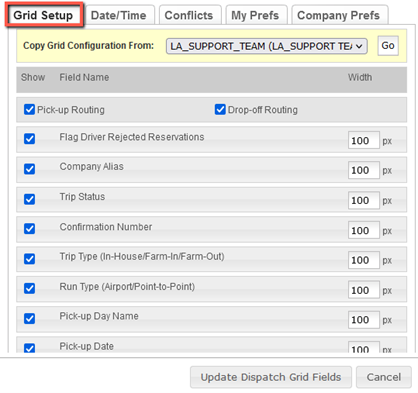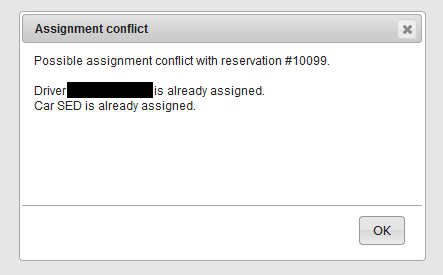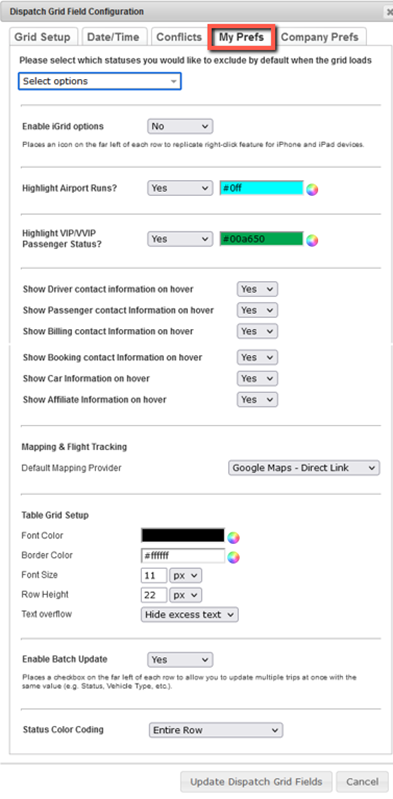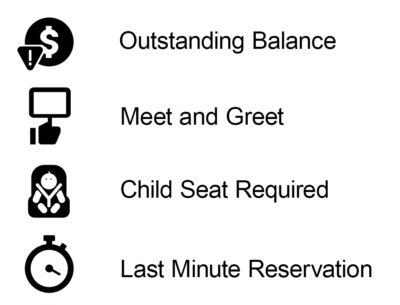Making the Most of Your Dispatch Grid

The Dispatch Grid serves as the central hub of your operations, tracking multiple drivers and vehicles, allowing you to manage changing flight times, traffic, weather, and delays, and helping you provide the best experience for your clients.
Just as no two operators are the same, no two dispatch grids are identical either. You may even have different layouts tailored to the specific workflows of roles like dispatchers, reservationists, detailers, and others within your organization.
In this blog post, we'll explore the various elements available when setting up your Dispatch Grid as well as some of the other available tools to help with your day-to-day operations.
Navigating to Grid Setup:
- Click on the ‘Dispatch‘ icon in the navigation bar.
- Click ‘Grid Setup‘ from the Dispatch screen.
- The following pop-up will feature five tabs:
- Grid Setup: Determines the columns of data that are to be present, the width of each column, and the order in which the columns appear.
- Date/Time: Settings associated with the date and time format, and the start and end time of the dispatch grid day.
- Conflicts: Switches the assignment conflict reminder on or off.
- My Prefs: Determines preferences for individual system users, including hiding jobs in certain statuses, enabling iGrid controls, and more.
- Company Prefs: Controls certain preferences that will apply for everyone in the company, such as flagging reservations and Driver Anywhere settings.
Grid Setup:
You can customize column placement by dragging and dropping options (columns) to suit your preferences. Placing an option at the top of the list positions it on the left-hand side of the dispatch grid, while placing it at the bottom of the list positions it on the right-hand side.
To activate or deactivate columns, simply check the box to the left of the label to include it in your dispatch grid, or leave it unchecked to remove it.
Adjust column width using the 'px' number box, specifying the width of each column in pixels. A smaller/larger number corresponds to a narrower/wider column width.
In your dispatch grid, you can manage various elements, including: Trip Type (In-House, Farm-In, Farm-Out), Company Name, Confirmation Number, Pick-Up Time, Duration, Drop-off Time, Passenger Name, Service Type, Flight Stats Scheduled Time, Flight Stats Actual Time, PU Routing as a single block, Vehicle Type, Number of Passengers, Garage-Out Time, Primary Driver Name, Secondary Driver Name, Primary Car, Trip Status, Dispatch Notes, Special System Notifications/Flags, Total Due, Payment Method, Occasion, Flag Driver Rejected Reservations, Trip Notes, Company Alias, Run Type (Airport/Point-to-Point), Pick-up Day Name (day of the week), Pick-up Date, Garage-In Time, Spot Time, PU Rt Name, PU Rt Address 1, PU Rt Address 2, PU Rt City, PU Rt State, PU Rt Zip, PU Rt Country, PU Rt Phone, PU Airline Name, PU Airline Code, PU Tail # in FBO, PU Flight #, DO Rt Name, DO Rt Address 1, DO Rt Address 2, DO Rt City, DO Rt State, DO Rt Zip, DO Rt Country, DO Rt Phone, DO Airline Name, DO Airline Code, DO Tail # in FBO, DO Flight #, Passenger Priority Level & Notes, Passenger Phone Number, Passenger Email Address, Primary Car Phone Number, Secondary Car, Secondary Car Phone Number, Bill To Account Number, Bill To/Contact Name, Group Name, Greeting Sign, Payment Status, PO/Client Ref#, Credit Card #, Affiliate Name, Affiliate Total, Affiliate Driver Name, Affiliate Driver Phone, Affiliate Car Name, Affiliate Car Phone, Primary Agent Name, Primary Agent Total, Secondary Agent Name, Secondary Agent Total, Luggage, Incident Report, Greeting Sign Notes, Grand Total, Extra Stops Indicator, Booking contact, Local PU Time, Affiliate Vehicle Class, Originating Trip Service, Farmed Out To, Flight Stats Terminal/Gate, Flight Stats Status, Preferred Driver, Preferred Secondary Driver, Preferred Vehicle Type.
Some of the items available on your dispatch grid communicate similar information in a different format, so you do not necessarily need to select every option. For example, PU Routing as a single block displays the pickup address details as a single field, whereas any of the PU Rt items display aspects of the address in separate fields on the grid. If you're primarily farming out trips to different markets, your dispatchers might prefer having the city and state separated from the street address so they can organize their grid by location.
Date/Time
- Choose the desired 'Date Format' from the drop-down list.
- Select the preferred 'Time Format' from the drop-down list.
- Determine how often the dispatch grid will refresh to display current trip statuses for the day by selecting from the 'Refresh Dispatch Every:' drop-down list.
- Set to 'Yes' if you want the Dispatch grid to automatically refresh after a payment is taken.
- Specify the 'Start Time' and 'End Time' of the Dispatch Grid Day that aligns with your company's business hours.
- Click the 'Update Dispatch Grid Fields' button to apply your selections.
Conflicts
By turning this feature on, a pop-up will appear to advise if there is a conflict (Driver or Car) between two or more trips.
My Prefs
- In the "Please select which statuses you would like to exclude by default when the grid loads" dropdown, tick the appropriate box next to any statuses that are not to be shown on the Dispatch Grid. For example, if "Done" trips are not to be shown, select "Done" from the drop-down list.
- By selecting 'YES' to enable iGrid options, a down arrow icon will appear on the far left of the Dispatch Grid, functioning identically to the action of 'right mouse click' on a PC or MAC. Note: This is required for iPad or other tablet devices where the 'right-click' action is not possible.
- Selecting "Yes" to highlight airport runs and/or VIP/VVIP Passenger status allows you to assign a color to those items, which will be highlighted on the dispatch grid.
- Setting the hover settings to “Yes” on the fields for Driver Contact, Passenger Contact, Billing Contact, Booking Contact, Car Information, or Affiliate Contact will display the appropriate information within the dispatch grid when the mouse pointer is placed over the respective section.
- Select the desired Default Mapping Link from the drop-down list, choosing from direct links to Google Maps or Yahoo Maps.
- In the Table Grid Setup section:
- Choose the desired color for the text in the grid display. The default is black (#000).
- Select the desired color for the borders in the grid display. The default is white (#FFFFF).
- Enter a value for the font size and specify if the value entered is in pixels (px) (default) or points (pt).
- Enter a value for the height of each row in the grid display and specify if the value entered is in pixels (px) (default) or points (pt). Helpful hint: the Row Height should be larger than the Font Size by a minimum of 2 pixels or 2 points.
- The text overflow selection controls how fields with text that exceeds the size of that particular field will appear on the grid.
- "Hide Excess Text" will allow only what can fit in the grid field size as determined in Grid Setup.
- "Show All Text" will automatically adjust the Row Height so that the complete text of that field can be shown.
- Enabling Batch Update places a checkbox on the far left of each row to allow you to update multiple trips at once with the same value. The fields that can be changed via Batch Update are Status, Vehicle Type, Driver1, and Car1. When selected in a Dispatch Grid, the Batch Edit window below will appear. Any changes made will apply to all selected (check box) trips when 'Batch Update Trips' is clicked.
- The Status Color Coding selection controls how the dispatch row is color-coded based on the status.
- Select "Entire Row" (default) to color the entire row based on the status, with the exception of cells in columns for Vehicle Type or Car, which may have their own specific color coding.
- Select "Status Column Only" to make the color coding for the Status only appear in the cells in the Status column.
Company Prefs
Note: To display the 'Flag' options on the Dispatch Grid, the column titled ' Special System Notifications/Flags' must be selected in the Grid Setup step above.
- Flag Reservations With Outstanding Balances:
- Select "YES" or "NO": Choosing "YES" places the flag code in the flag column of the Dispatch Grid if the reservation is not paid in full.
- Flag Reservation with Meet and Greet:
- Select "YES" or "NO": Opting for "YES" puts the flag code in the flag column of the Dispatch Grid if the reservation has a Meet and Greet requested.
- Flag Reservations With Child Seats:
- Select "YES" or "NO": Opting for "YES" places the flag code in the flag column of the Dispatch Grid if the reservation has Child Seats requested.
- Flag Reservations Booked Less Than:
- Selecting an option from the drop-down list places the flag code (Last Minute) in the flag column of the Dispatch Grid if the reservation was created less than the number of hours selected before pickup time.
- Other Company Preferences:
- Select "YES" or "NO" for “Display DO and Spot Time in Quick Edit Form”:
- Choosing "YES" adds the Drop Off Time and Spot Time fields to the Quick Edit Form accessed by right-clicking the trip in the Dispatch Grid, or selecting the iGrid control icon, and selecting the "Quick Edit" option.
- Flag Driver Rejected Reservations:
- Note: Before enabling this setting, make sure you have selected “Flag Driver Rejected Reservations” in your Grid Setup, otherwise the information will not appear on your grid.
- Selecting "YES" will add color-coding to trips in the appropriate field:
- Gray if a trip has been dispatched and the driver has not accepted or rejected it
- Red if a trip has been dispatched and the driver has rejected it
- Green if a trip has been dispatched and the driver has accepted it
- Enable Driver Anywhere Messaging:
- Selecting "YES" enables sending a driver a message from the Dispatch Grid through Driver Anywhere by right-clicking the trip in the Dispatch Grid, or selecting the iGrid control icon, and selecting the option "Send to DA".
- Select "YES" or "NO" for “Display DO and Spot Time in Quick Edit Form”:
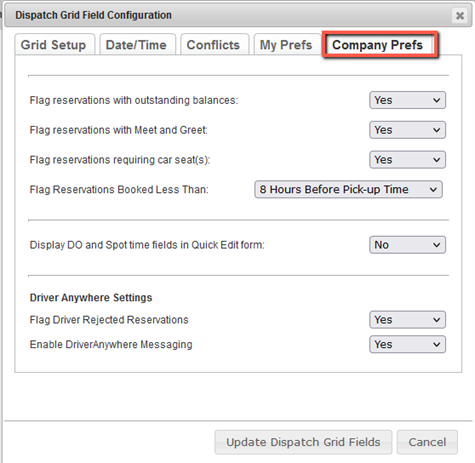 Click the “Update Dispatch Grid Fields” button to save any changes.
Click the “Update Dispatch Grid Fields” button to save any changes.


